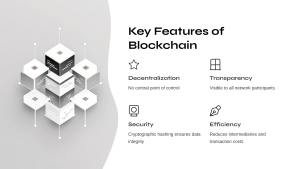Blockchain Basics: 10 Key Features, How It Works, and Future Potential

Table of Contents
Blockchain Basics is revolutionizing how we think about digital trust, data security, and decentralized systems. Originally developed by Satoshi Nakamoto in 2008 to support Bitcoin, blockchain has since become an innovation with wide-reaching effects on various industries. In this article, we’ll break down the basics of blockchain, how it works, and why it has the power to change finance and many other sectors of the global economy.
What Is Blockchain Basics?
Blockchain Basics is a type of distributed ledger technology (DLT). Simply put, it’s a decentralized database, or ledger, that records transactions across a network of computers. Unlike traditional databases, where data is stored in one central place, blockchain operates on a peer-to-peer network. This means all participants have the same version of the data, which is key to its security and transparency.
The blockchain ledger is made up of blocks, which are collections of transaction data. Each block links to the previous one, forming a chain—hence the name “blockchain.” Once information is stored in a block, it cannot be easily changed, providing a secure and tamper-proof record. This immutability is made possible by cryptographic hashing, making blockchain an incredibly reliable way to store information.
How Does Blockchain Basics Work?

To understand blockchain better, let’s break down its main parts and processes:
1. Blocks
Each block contains three key parts—data, a unique hash, and the hash of the previous block. The data varies depending on the blockchain’s use case. For Bitcoin, it includes details like the sender, receiver, and the amount transferred. Each block also contains a hash, a unique digital fingerprint created by a cryptographic algorithm that identifies it.
2. Hashing and Linking
The hash of a block is what links it to the previous one, creating a chain. If anything in a block changes, its hash also changes, which in turn breaks the link to the next block. This design is what makes blockchain resistant to tampering.
3. Consensus Mechanisms
In a decentralized network, it’s important to agree on which transactions are valid. Blockchain uses consensus algorithms like Proof of Work (PoW) or Proof of Stake (PoS) to make sure all participants are on the same page. This consensus keeps the data trustworthy without needing a central authority.
4. Nodes
The blockchain network consists of nodes, which are computers that are connected to the network. Each node keeps a full copy of the blockchain ledger. Nodes help validate transactions and spread them across the network. Some nodes, called miners, also compete to add new blocks to the chain.
10 Key Features of Blockchain Basics

- Decentralization: Unlike systems that rely on a single authority, blockchain is decentralized, which means there is no central point of control. This makes it resistant to censorship, fraud, and outages.
- Transparency: Everyone in the network can view the data recorded on the blockchain, increasing trust and accountability.
- Security and Immutability: With cryptographic hashing and consensus protocols, data on the blockchain is highly secure and cannot be changed after it is recorded.
- Efficiency: Blockchain basics enable efficient transactions by cutting down intermediaries, which reduces both time and cost.
- Smart Contracts: Smart contracts allow automated and secure agreements to be executed without intermediaries, lowering transaction risk.
- Distributed Ledger: Every participant in the blockchain network has access to the distributed ledger, which ensures consistency and reliability of data.
- Reduced Costs: By removing intermediaries, blockchain reduces transaction costs.
- Traceability: Blockchain ensures that all transactions are traceable, which is especially useful in supply chain management.
- Programmability: Some blockchains, like Ethereum, allow developers to create programmable logic that automatically triggers actions.
- Resilience: The distributed nature of blockchain makes it more resilient to system failures.
Types of Blockchain

There are different types of blockchains, each suited for specific purposes:
- Public Blockchain: Open to anyone and fully decentralized. Examples include Bitcoin and Ethereum.
- Private Blockchain: Access is restricted, often used by companies that need privacy and control. Hyperledger is a popular example.
- Consortium Blockchain: A mix of public and private, controlled by a group rather than one single entity, which makes it suitable for collaborative projects.
Applications Beyond Cryptocurrency

Although blockchain’s first major use was for Bitcoin, its potential extends far beyond cryptocurrencies. Here are some industries it is impacting:
- Supply Chain Management: Blockchain improves transparency in tracking products from the producer to the consumer, reducing fraud and inefficiencies.
- Healthcare: Patient records can be securely stored and shared by authorized people, ensuring privacy and data security.
- Finance: Besides cryptocurrencies, blockchain enables fast, secure, and low-cost international payments, avoiding traditional banks.
- Smart Contracts: Platforms like Ethereum allow smart contracts, which are self-executing agreements without needing intermediaries, lowering costs and reducing risk.
Challenges Facing Blockchain Basics

Despite its strengths, blockchain has challenges:
- Scalability: Current blockchains find it hard to handle large numbers of transactions quickly. Innovations like Layer 2 scaling solutions and sharding are being developed to address this.
- Energy Consumption: Proof of Work, used by Bitcoin, uses a lot of energy. Proof of Stake and other alternatives are less energy-intensive and offer more sustainable options.
- Regulation: The regulatory landscape for blockchain and cryptocurrencies is still uncertain in many areas. Governments are still figuring out how to manage this fast-changing technology.
The Future of Blockchain Basics
Blockchain’s decentralized and secure nature holds the promise of changing many industries. As blockchain technology grows, new uses like Decentralized Finance (DeFi) and Non-Fungible Tokens (NFTs) are proving its potential beyond financial transactions. Innovations in consensus mechanisms and better network connections will further improve blockchain, making it usable for more widespread applications.
Conclusion
Blockchain Basics is reshaping how we think about data ownership, trust, and security. It offers a new foundation for building trust in the digital world without intermediaries. By understanding the basics of blockchain—how it works, its features, and its potential—we can better appreciate why it is considered one of the most disruptive technologies today.
If you are ready to learn more about blockchain’s technical details or its real-world applications, stay tuned for future articles in this series. Blockchain Basics is the start of a new digital era, and learning about it is the first step to using its power for future innovation.

For more details, visit Wikipedia on Blockchain.
Also, check our other articles on Blockchain Applications for more insights.